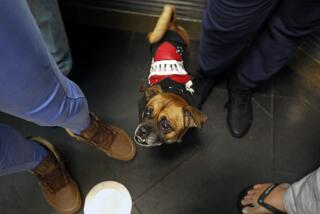For Sick Children, a Helping Paw
- Share via
ALBANY, N.Y. — Jane is scampering around the children’s cancer center, nuzzling a toddler who had a brain tumor removed, when 14-year-old Alexia walks in.
Girl and dog both flop on the hospital floor. Alexia scratches Jane’s belly two-handed and gives a big smile. Jane licks Alexia’s face.
The two met when Alexia was horribly sick with non-Hodgkin’s lymphoma, when she was suffering through chemotherapy, when she was sad and wanted a friend. Alexia couldn’t get out of her hospital bed then, so Jane would curl into bed with her.
“She saved the day,” Alexia says, rubbing Jane’s thick black coat near her “I Am a Therapy Dog” tag until Jane’s handler, Teri Conroy, walks her over to another child who’s in for treatment.
Therapy dogs, so often associated with nursing homes, have expanded their range. The animals comfort people everywhere, including disaster sites, hospitals, schools, even prisons. A recent trend is for dogs such as Jane to work in libraries, helping children practice reading aloud. The dogs provide an attentive, non-judgmental audience for young readers still building up their confidence.
At Green Chimneys in Brewster, N.Y., students not only read to dogs to build up confidence, they train dogs too.
“It works for some difficult students you have trouble reaching,” says spokeswoman Deborah Bernstein. “It’s a wonderful way to reach them and motivate them to do better in school.”
Therapy Dogs International has registered more than 12,000 dogs and 9,500 handlers. Another nationwide animal group, Delta Society, has about 8,000 “pet partner” teams, most of them the people-and-dog variety, but it also has teams featuring cats, rabbits, pigs and other animals.
At Albany Medical Center, doctors and nurses rely on volunteers such as Conroy and dogs such as Jane, a 2 1/2 -year-old Portuguese water dog. Jane likes to lick faces and will hop on hospital beds to get to one if invited.
When a boy on a pediatric ward greets her wearing a surgical mask, Jane licks the mask. The boy puts on purple gloves to scratch Jane’s tummy.
“Oh, you don’t want me to stop,” the boy says. “You’re so cute!”
Jane is part of a troupe of about 14 dogs working the halls of the medical center. Among the others are Honor, a snow-colored 130-pound Great Pyrenees who wears sunglasses, Honee, Muddy, Darla, Rocky and Viva.
Each has its own bedside manner. Jane is bubbly. Seamus is laid-back. Honee, a 9-pound Coton de Tulear, can be picked up. Honor cannot, and sometimes naps during group therapy.
Dogs are dispatched around the hospital based on requests from medical workers. Sometimes, three dogs at one time are visiting the young, the old, the recovering and the terminal. Dr. Richard Sills, director of Albany’s Center for Childhood Cancer and Blood Disorders, says the dogs cheer up children and make hospitals more welcoming.
“The demand is always more than the supply,” says Kelly Morrone, manager of volunteer services. “Never enough dogs.”
Jane is popular at the pediatric cancer center, where she has seen many of the children through hard times. Alexia, in remission now, used to get visits in the examining room and in her bed when things were touch and go.
“She would be out of it and she would be so weak and she would be talking about the dog coming by,” says Alexia’s mother, Pam Eubanks. “This was like the only thing when she was sick -- and she was sick constantly when she got diagnosed -- this was the only thing that raised her spirit.”
Therapy dogs can be any breed, but dogs certified by Therapy Dogs International must meet standards for disposition, obedience and appearance. As part of her test, Jane had to walk past a cookie left in the open and navigate calmly through a jostling crowd.
Conroy is content being Jane’s anonymous partner -- or “the other end of the leash,” as she calls it. Melting away pain, even for a moment, makes it worth it for her. She lights up when talking about patients in remission, such as Alexia. Still, the work can be hard. Her face clouds over talking about children who didn’t get a happy ending and the obituaries she has read.
“There are days when I cry on the way home,” she says.
Jane also seems attuned to patients’ needs. She will jump up and lick the face of one patient who revels in it. But she is reserved after a nurse whispers to Conroy that there’s a newly diagnosed girl sitting quietly with her mom. She could use a visit, the nurse says.
Jane pads up to the teenager. The girl gives Jane an absent pat on the head. Conroy chats with mother and daughter about dogs. Jane leans in close to the girl, who strokes her back, gently working her fingers through the thick coat.
“For five minutes she was asking me about my dog and was talking about her dog,” Conroy says, “and not thinking about all that chemotherapy.”
More to Read
Sign up for Essential California
The most important California stories and recommendations in your inbox every morning.
You may occasionally receive promotional content from the Los Angeles Times.













